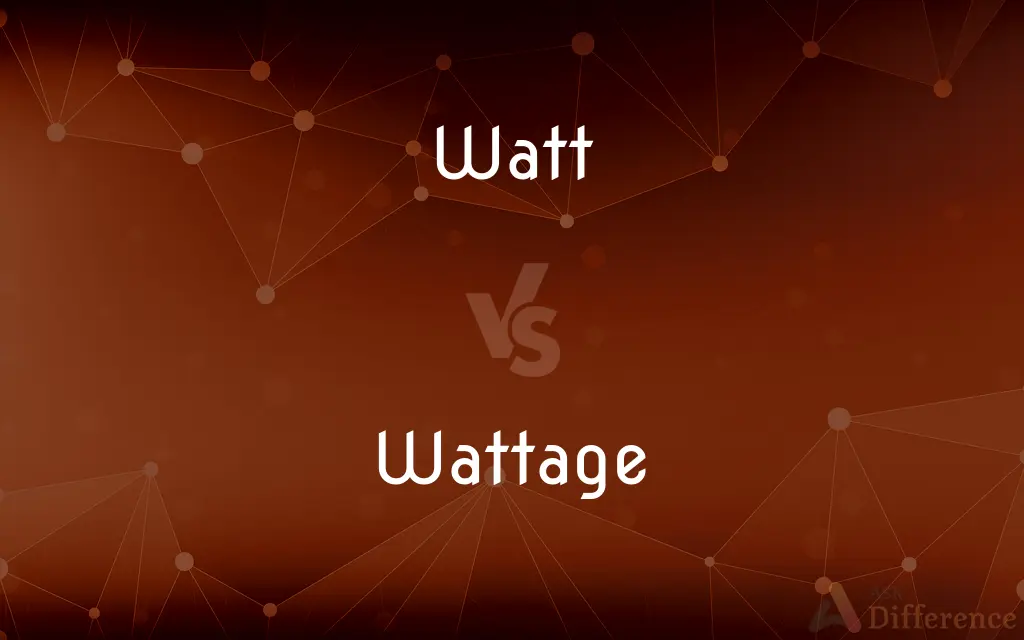Watt vs. Wattage — What's the Difference?
By Maham Liaqat & Urooj Arif — Updated on February 29, 2024
"Watt" is a unit of power representing the rate of energy transfer, while "wattage" refers to the amount of power expressed in watts used by a device or produced by a source.

Difference Between Watt and Wattage
Table of Contents
ADVERTISEMENT
Key Differences
A watt (W) is the SI unit of power, quantifying the rate at which energy is used or transferred over time. It is defined as one joule per second. For instance, a device that uses one joule of energy every second is said to have a power consumption of one watt. Wattage, on the other hand, is a term that describes the amount of electrical power measured in watts. It is often used to specify the power consumption of appliances or the power output of generators and other energy sources.
The distinction between watt and wattage is similar to the difference between other units of measure and the measurement they represent. For example, "watt" is to "wattage" as "meter" is to "length." This distinction is crucial for clear communication, especially in contexts related to electrical engineering, consumer electronics, and energy policy.
When discussing the energy efficiency of an appliance, the term "wattage" is commonly used. For example, an LED bulb may have a wattage of 10 watts, indicating its power consumption, whereas "watt" is used when referring to the unit of measurement itself. Understanding the difference is essential for making informed decisions about energy use and efficiency.
The concept of wattage is integral to discussions about energy consumption and sustainability. By comparing the wattage of different devices, consumers can make choices that reduce energy consumption and lower utility bills. Additionally, in renewable energy systems, wattage is used to describe the power output capacity of equipment such as solar panels and wind turbines.
Comparison Chart
Definition
A unit of power equal to one joule per second
The amount of power, in watts, used or produced
ADVERTISEMENT
Usage
To measure the rate of energy transfer
To describe power consumption or output
Context
Scientific and technical measurements
Consumer electronics, energy efficiency
Examples
"This device operates at 100 W"
"The wattage of this lamp is 60 W"
Importance
Fundamental unit in physics for power
Helps in assessing energy use and efficiency
Compare with Definitions
Watt
Basis for electrical calculations.
Calculating energy costs requires knowing the watts used.
Wattage
Power level of an electrical device.
The wattage of the heater is 1,500 watts, indicating its power consumption.
Watt
Measures energy transfer rate.
A solar panel produces up to 300 watts in direct sunlight.
Wattage
Indicates power output capacity.
The generator's wattage is crucial for determining how many devices it can power.
Watt
Unit of power in the International System of Units.
A lightbulb uses 40 watts of power.
Wattage
Describes appliance energy use.
Comparing the wattage of lightbulbs helps in choosing the more energy-efficient option.
Watt
Reflects energy efficiency.
Modern appliances often operate at lower wattages to save energy.
Wattage
Used in product specifications.
Electronics are often labeled with their wattage for consumer information.
Watt
The SI unit of power, equivalent to one joule per second, corresponding to the rate of consumption of energy in an electric circuit where the potential difference is one volt and the current one ampere.
Wattage
Helps in energy management.
Knowing the wattage of appliances can aid in reducing electricity bills.
Watt
Used in specifying electrical devices.
The motor has a maximum output of 750 watts.
Wattage
An amount of power, especially electric power, expressed in watts or kilowatts.
Watt
The watt (symbol: W) is a unit of power or radiant flux. In the International System of Units (SI), it is defined as a derived unit of (in SI base units) 1 kg⋅m2⋅s−3 or, equivalently, 1 joule per second.
Wattage
The electric power required by an appliance or device.
Watt
In the International System of Units, the derived unit of power; the power of a system in which one joule of energy is transferred per second. Symbol: W
Wattage
An amount or power (especially electric), expressed in watts, kilowatts etc.
Wattage
The power requirement of some electric appliance.
Wattage
The product of voltage and current
Common Curiosities
What is a watt?
A watt is the SI unit of power, indicating the rate of energy transfer equivalent to one joule per second.
Why is understanding wattage important for energy efficiency?
Understanding wattage helps in selecting appliances that use less power, contributing to energy savings and sustainability.
How is wattage relevant to household appliances?
Wattage determines the power consumption of appliances, affecting energy use and electricity bills.
Can watt and wattage be used interchangeably?
While related, they are not interchangeable; watt is a unit of measurement, and wattage describes the power level of a device or system.
What role does wattage play in renewable energy systems?
Wattage indicates the power output of renewable energy systems, such as solar panels, essential for sizing and planning installations.
Is higher wattage always better for appliances?
Not necessarily; higher wattage means higher power consumption, which isn't always efficient or necessary.
How does wattage affect electrical systems design?
Designing electrical systems requires knowing the wattage to ensure adequate power supply and safety measures.
What does wattage mean?
Wattage refers to the amount of power, measured in watts, that an electrical device uses or a power source produces.
How do you calculate the energy cost from wattage?
Multiply the appliance's wattage by the hours of use and the electricity rate to calculate energy cost.
What is the significance of wattage in product labels?
Wattage on product labels informs consumers about the power consumption, helping them make informed choices.
Share Your Discovery

Previous Comparison
Coil vs. Curl
Next Comparison
Pork vs. ForkAuthor Spotlight
Written by
Maham LiaqatCo-written by
Urooj ArifUrooj is a skilled content writer at Ask Difference, known for her exceptional ability to simplify complex topics into engaging and informative content. With a passion for research and a flair for clear, concise writing, she consistently delivers articles that resonate with our diverse audience.














































